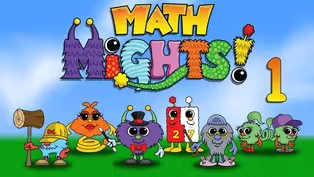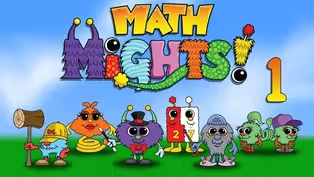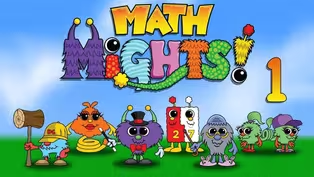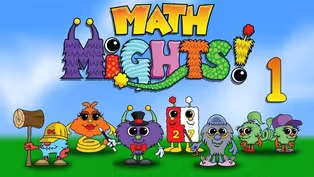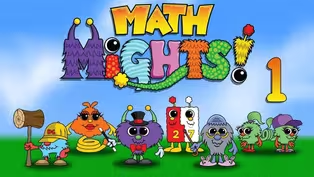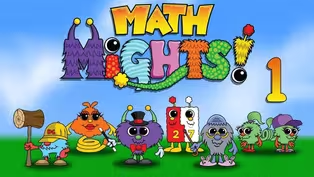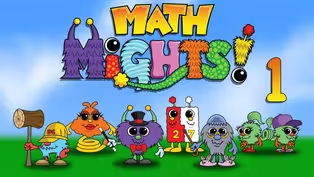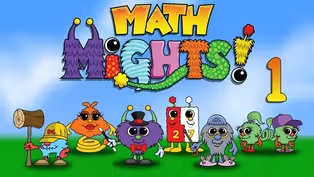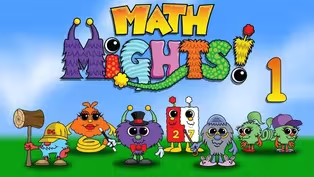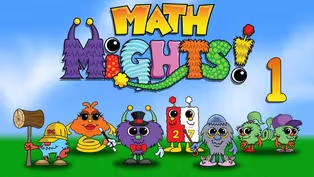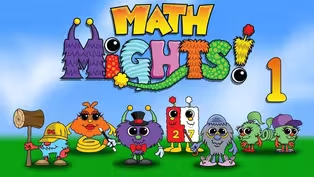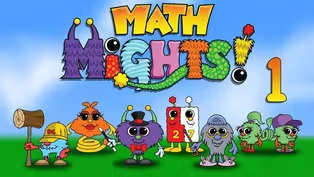Math Mights
Adding 2-Digit Numbers
Season 2 Episode 215 | 16mVideo has Closed Captions
Join Mrs. Markavich for Numeracy Talk with Dotson.
Join Mrs. Markavich for Numeracy Talk with Dotson working on conservation to 20. Get your math brain ready to have some fun with adding two-digit numbers.
Problems playing video? | Closed Captioning Feedback
Problems playing video? | Closed Captioning Feedback
Math Mights is a local public television program presented by Detroit PBS
Math Mights
Adding 2-Digit Numbers
Season 2 Episode 215 | 16mVideo has Closed Captions
Join Mrs. Markavich for Numeracy Talk with Dotson working on conservation to 20. Get your math brain ready to have some fun with adding two-digit numbers.
Problems playing video? | Closed Captioning Feedback
How to Watch Math Mights
Math Mights is available to stream on pbs.org and the free PBS App, available on iPhone, Apple TV, Android TV, Android smartphones, Amazon Fire TV, Amazon Fire Tablet, Roku, Samsung Smart TV, and Vizio.
Providing Support for PBS.org
Learn Moreabout PBS online sponsorshipMore from This Collection
Video has Closed Captions
Join Mrs. Markavich for a missing addend word problem with Professor Barble! (16m 5s)
Adding Tens-Tens and Ones-Ones
Video has Closed Captions
Join Mrs. Markavich for a missing addend word problem with Professor Barble! (15m 35s)
Write Equations to Match the Strategy
Video has Closed Captions
Join Mrs. Markavich for a missing addend word problem with Professor Barble. (16m 2s)
Video has Closed Captions
Join Mrs. Markavich for a subtraction word problem with Professor Barble. (15m 59s)
Video has Closed Captions
Join Mrs. Markavich for a missing addend word problem. (16m 6s)
Add 2-Digit Numbers & Write Equations
Video has Closed Captions
Join Mrs. Markavich for a word problem with her friend Professor Barble! (15m 59s)
Comparing Numbers Different Ways
Video has Closed Captions
Value Pak shows you the different ways to compare 2-digit numbers. (15m 44s)
Video has Closed Captions
Join Mrs. Markavich for a word problem with her friend Professor Barble! (15m 59s)
Video has Closed Captions
Join Mrs. Markavich for a word problem with her friend Professor Barble! (15m 59s)
Decompose/Compose #'s Different Ways
Video has Closed Captions
We show you different ways to decompose and compose 2-digit numbers! (15m 59s)
Video has Closed Captions
Join Mrs. Markavich & Dotson to talk about numbers with the Counting Buddy Senior! (16m)
Video has Closed Captions
Join Mrs. Markavich & Dotson for a Numeracy Talk with the Counting Buddy Senior (16m)
Providing Support for PBS.org
Learn Moreabout PBS online sponsorship(bright music) - [Children] Math Mights.
- Welcome back, first grade Math Mights.
I'm Mrs. Markavich, and I'm so excited that you're back with us today.
We're going to have so much fun with our friend Dotson doing a numeracy talk.
Let's check out our plan for the day.
Today, we'll be doing a numeracy talk with our friend Dotson and then we'll be adding two digit numbers.
I want to warm up your brain first.
Let's get ready to do a numeracy talk with our friend Dotson.
Remember him from the other day?
He's so much fun.
Dotson is a character and Mathville.
Dotson got his name because he loves to see dots.
Dotson is a subitizing superhero.
Hmm.
What is subitizing?
Subitizing is when you can tell me a number without counting it.
I want you to get your camera ready to take a picture of our famous double 10 frame.
We saw that the last time.
Remember, you're going to take a picture and hold it there.
Don't tell me this time what you see.
Keep it a secret, because I have a special secret to share with you after.
This time, I don't want you to tell me how many you saw.
My secret is that I want you to tell me two less than what you see on our famous double 10 frame.
I have two friends who have some ideas.
Let's take a look at theirs.
My friend Harper thinks that she saw 18.
So, two less would be 20.
Good thinking, Harper.
I wonder, did you see the same thing that Harper saw?
Well, let's take a look at my friend Keesha.
Keesha thinks that she politely disagrees with Harper because Keesha saw 18 and two less would be 16.
Hmm, maybe you agree with my friend Keesha.
Let's take a look and see how Keesha solved it and then we'll go back and we'll talk about how Harper solved it.
Take a look here on my double 10 frame mat.
And you can see that we have 10 on top, so we don't have to count them, and then we have five, and three more is our 18.
And my friend Keesha said that two less than 18, one, two, is 16.
Kiss your brain, Keesha.
And if you have the same answer as Keesha, you kiss your brain too, just like this.
Great job.
Now, let's take a look at how my friend Harper solved it.
Harper said that two less than 18 was 20.
And that looks like this.
We still have 10 on top, five, which is 15, 16, 17, 18, 19, 20.
Oops.
Remember, when we say less, we mean to take some away, not to add them.
So, two less than 18 would be 16.
Guess what?
If you got 20 like my friend Harper, that's okay, because sometimes we make mistakes and math but we learn from those mistakes and we try again the next time.
So boys and girls, great work on our numeracy talk today.
Let's take a look at our I can statement.
Today, our I can statement says, I can understand that adding two digit numbers means I add the tens, then I add the ones.
Let's head on over to our first activity.
Who knows?
Maybe we'll see our friend Value Pak there.
In Mathville, we have a family, and that family is called Value Pak.
And Value Pak family wears their numbers on their belly.
There are two parts.
There is a red part which represents the tens, and a white part which represents the ones.
Let's take a look.
Is each statement true or false?
And I want you to use words to explain your thinking.
My friend JJ is looking at this statement: 80 plus five equals five plus 80.
JJ says, "This is true because we can change the order and the sum is still the same."
Let's take a look and see if he is right.
He said, 80 plus five equals five plus 80.
Remember, when we're talking about tens and ones, we have 80 for eight tens and we add five ones to make 85.
Don't get confused and put that five in front of the eight.
Remember, we have the tens for 80, add five ones for 85.
And we have the same number on both sides.
85 equals 85.
Great job, JJ.
Let's see what our friend Amaya thinks.
Amaya's statement says: 70 plus one equals 80 plus one.
Amaya says, "This is false because there are seven tens on one side and eight tens on the other side, so that isn't equal."
Let's take a look.
I have it out here for us.
We have 70 plus one equals 80 plus one.
So let's remember to look at those tens.
I have seven tens on this side and I have eight tens on this side.
Seven tens make 70.
70 plus one equals 71.
Eight tens equals 80.
80 plus one equals 81.
When I take a closer look at this, I can see that I only have seven tens on this side and eight tens on this side.
So, Amaya is right.
This is not equal.
71 does not equal 81.
Great job, Amaya.
Let's take a look at my last friend, Deion, and see what he thinks.
His equation says: 20 plus six equals six plus 30.
Deion says, "This has to be false because even though they both have the same number of ones, the tens are not the same."
And I have it set up here for us.
So remember, let's look.
We have 20 plus six equals six plus 30.
I have two tens which makes 20.
20 plus six ones is 26.
On this side, I have six plus 30.
But remember, don't get confused by the six coming first.
We always put the tens first.
So we have 30 plus six ones is 36.
Take a look at that.
Hmm.
26 is not the same as 36.
So my friend Deion is right.
26 is not equal to 36.
Great job, friends.
Let's take a look at adding tens and ones with some cubes.
I have the equation: 37 plus 20.
Hmm.
I wonder what that equals.
Let's take a look.
I'm going to slide these apart.
It's kind of magical.
10, 20, 30, here's my number 30.
Let's count the ones.
One, two, three, four, five, six, seven.
30 add seven, remember to hide that zero, is 37.
I'm going to pull it back apart and look over here at my other set of tens.
I have 10, 20.
Here is my number 20.
I want to add them together.
I want these tens to combine or add with these tens.
When I do that, it looks like this.
We're going to move them over, and now I am going to count.
10, 20, 30, 40, 50, 51, 52, 53, 54, 55, 56, 57.
And I get the number 57.
I have five tens and seven ones.
Great work, first graders.
Let's take a look at another equation.
It's time to find the value that makes this equation true.
50 plus 23.
And I brought back my giant abacus so that we can use this to count by tens and add our ones.
Let's take a look at adding 50 plus 23 to figure out the hmm.
Remember, we're going to count by tens.
Count with me.
10 20, 30, 40, 50.
This is the number 50.
We need to add 23.
23 looks like this on the abacus.
10, 20, 21, 22, 23.
Let's look at the 23.
It looks like this.
A two and a three make 23.
Now remember, we have to add 50 plus 23 to get hmm.
So we have 10, 20, 30, 40, 50, 60, 70, 71, 72, 73.
And the number 73 looks like this.
We have seven tens and three ones.
So, 50 add 23 equals 73.
Great job, Math Mights.
Wasn't that so much fun with our giant abacus?
I wonder now if we can solve another problem with our base 10 blocks.
Let's take a look.
I have a new equation.
This equation looks a little different than what you're used to seeing.
This time, our equation starts with an equal.
It says: equal 48 plus 50.
I like to say, hmm equals 48 plus 50.
Let's take a look at my place value board and see if we can figure out this equation together.
On my place value board, I have tens and ones.
The tens are always on the left and the ones are always on the right.
If I look at my number and I pull it apart, you can see that I have 40 and eight.
On my place value board, let's start by counting by tens.
I have 10, 20, 30, 40.
Now, don't forget to count on an add those ones.
So remember, put it in your head.
40, 41, 42, 43, 44, 45, 46, 47, 48.
Have that eight, hide that zero, and you get 48.
Now, I need to add 50.
I'm going to bring over some more base 10 blocks.
Let's count by tens.
Remember, they go on the tens side.
10, 20, 30, 40, 50.
And 50 looks like this.
I have all the base 10 blocks I'm going to need.
Now, I need to add them all together to see the total.
Let's start by counting by tens.
Ready?
10, 20, 30, 40, 50, 60, 70, 80, 90.
Put that 90 in your head.
I'm going to show you what it looks like.
Here is 90.
Now, we can't forget to count those ones.
So say that number.
90, 91, 92, 93, 94, 95, 96, 97, 98.
Hide that zero, and I have 98.
Great job, Math Mights.
Kiss your brain.
Now it's time for you to try it on your own.
It's time to add some tens and ones.
Boy, you really worked hard today, first grade Math Mights.
We used a giant abacus, counters, and some base 10 blocks to count tens and ones.
I sure hope you'll join me next time when we continue to talk about math.
Have a great day, Math Mights.
(bright music) - [[Narrator] Sis4teachers.org, changing the way you think about math.
- [Narrator] This program is made possible with funding from the Michigan Department of Education, Governor's Education Emergency Funds, the state of Michigan, and by viewers like you.
(bright music)


- Home and How To

Hit the road in a classic car for a tour through Great Britain with two antiques experts.










Careers that Work

Support for PBS provided by:
Math Mights is a local public television program presented by Detroit PBS
